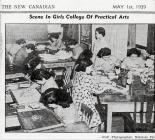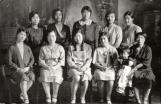1
Japanese Canadian Dressmaking AcademiesDressmaking schools and academies provided formal, structured courses ranging from one to several years. These schools were attended by women who wanted to pursue a career in dressmaking as well as women who wanted to learn to sew and make clothing for themselves and their families.
2
Sewing School in Vancouver, B.C., ca. 1920. JCNM Photograph Collection1920
Vancouver, BC
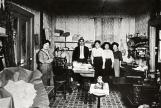 Credits:
Credits:Masaye Sato
3
Schools and instructors were concentrated mainly in Vancouver, but operated also in places elsewhere in the region such as Mission and Steveston. Among these were the Women's Sewing School, Matsuzaki's School of Dressmaking and Tailoring, the Marietta School of Costume Design, the Academy of Domestic Arts, and the Girls College of Practical Arts.As Susan Michi Sirovyak observes, "A healthy competition between the schools for the recruitment of new students is evident from articles and advertisements which ran in The New Canadian, the local Japanese Canadian newspaper... These schools provided comprehensive and individual instruction and awarded the students a diploma upon graduation."
4
Advertisement for the Academy of Useful Arts, Vancouver, BC, 1930s. JCNM Ephemera.1930
Vancouver, BC
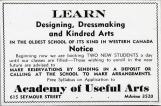
5
Kay Tatebe, a dressmakerKay Tatebe (nee Shimoda) attended the Kita School of Dressmaking at Cordova and Jackson in Vancouver, living with Mrs. Kita with six other girls. Graduating in approximately 1930, she opened a dressmaking shop in New Westminster in 1931, which she operated until evacuation in 1942. She spoke with Susan Michi Sirovyak of the Japanese Canadian National Museum about the Kita school:
"In my days hardly anyone went to high school. Instead of high school we went to sewing school. No Japanese were allowed to be nurses, or teachers ... There was a dressmaker on every corner and they were mostly Japanese. It was the only trade they were able to do other than working in the cannery or housekeeping. ... In the morning we got up. We took turns making breakfast, lunch and dinner. ... After supper, we'd be in the shop until about midnight sewing out in the front. That's the only recreation we had in those days."
From a conversation with Susan Michi Sirovyak, Japanese Canadian National Museum, June 1996.
7
Portrait of the Mission Bukkyo Fujin Kai (Buddhist Women's Association) Sewing Club, in 1932.1932
Mission, BC

8
Kohide Nakamura taught dressmaking in Mission, BC, in the 1930s. She instructed her students at the Buddhist church in Mission, bringing her own sewing machines among others for the students to use. There were about five or six machines at the school. She also brought her daughter, Emiko, with her to the classes she gave that covered the essentials of pattern drafting, sewing and dressmaking.Adapted from a conversation of Chizu Nakamura with Susan Michi Sirovyak, Japanese Canadian National Museum, 1996.
9
Portrait of the Mission Bukkyo Fujin Kai (Buddhist Women's Association) Sewing Club, 1935.1935
Mission, BC

10
"It was there, in Haney, BC, that my mother grew up and where my grandparents farmed for almost thirty years -- until 1942, when they were forced to relocate, ironically enough, to northern British Columbia. The Haney photographs portray the rich social life of a small insular community. My grandmother was active in the Japanese women's association and the women's auxiliary of the Buddhist church. Her album contains pictures of her family, her best friends, and their children, as well as of community weddings, funerals, and church socials. Amid the photos are pictures of my grandmother with her girlfriends. Astonishingly, I have discovered that one of these women was the grandmother of Art Miki, the president of the NAJC [National Association of Japanese Canadians], and his brother Roy, one of the principal organizers in Vancouver; and another was the great aunt of Audrey Kobayashi, a leader in the Montreal Japanese Canadian community. Four of the six redress negotiators can trace their roots back to these women.My Hamilton aunt recalls that my grandmother and her chums declared January their month because there was no work to be done then on the farms. They would gather up their youngest children and move in with one another, spending the time sewing and enjoying each other's company. In the 1940s the three families were removed from the Fraser Valley and scattered across the country, from Vancouver to Montreal. Yet somehow, two generations later, we who had previously been strangers to one another were brought together through the redress movement.
Although my grandparents lived with my family until I was five, I have few recollections of my pioneer grandmother. Yet I am sure that she is secretly pleased that her grandchild and the grandchildren of her friends helped lay to rest the wartime injustice done to our community."
Maryka Omatsu, Bittersweet Passage: Redress and the Japanese Canadian Experience.
11
Graduation certificate of Eiko Ishida, from the Academy of Domestic Arts at Steveston, BC, in 19361936
Steveston, BC
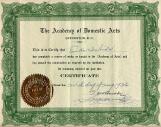
13
From a Letter to Susan Michi Sirovyak from Mary Fumiko Ikeda Otto"It was a pleasant surprise to be invited to share a part of my life experience of those youthful topsy turvy days. Before the war, I studied dressmaking and tailoring at the Matsuzaki School (1938). Craftwork with wool, embroidery, and cutwork was all part of the course for a diploma. My main interest was of course dressmaking and as my aspiration grew my dream and goal headed towards becoming a dress designer. I studied the proportions of sketching a figure and drew my ideas on paper to design and produce a garment.
Matsuzaki Sensei's system of drafting was with a square ruler. For tailoring it is the precise way of drafting. I made two men's suits and pants, slacks and vests. I enjoyed the feel of good quality textiles and I became familiar with the stores that handled the best fabrics.
In those days we did a lot of walking. To the schools, downtown shopping, to church or visiting, walking was apart of our life if one needed to get anywhere ... and so during the summer months when many of my friends went to farms to pick strawberries and tomatoes, I walked Mon. to Fri. to the Matsuzaki School of Dressmaking and Tailoring. Later I attended Marietta School of Costume Design headed by Miss Dorothy Haruko Morishita, in Vancouver. Marietta's drafting was done with a foot ruler. Simple to learn and the finished garment usually was excellent.
After I received my diploma I sent for a home study course on dress designing. To this day I have the whole course almost untouched ... The war started as I was beginning to look into a school of designing, which brought my dream on hold temporarily."
Mary Fumiko Ikeda Otto
14
Newspaper image, showing the Girls' College of Practical Arts at Vancouver, BC.1 May 1939
Vancouver, BC
